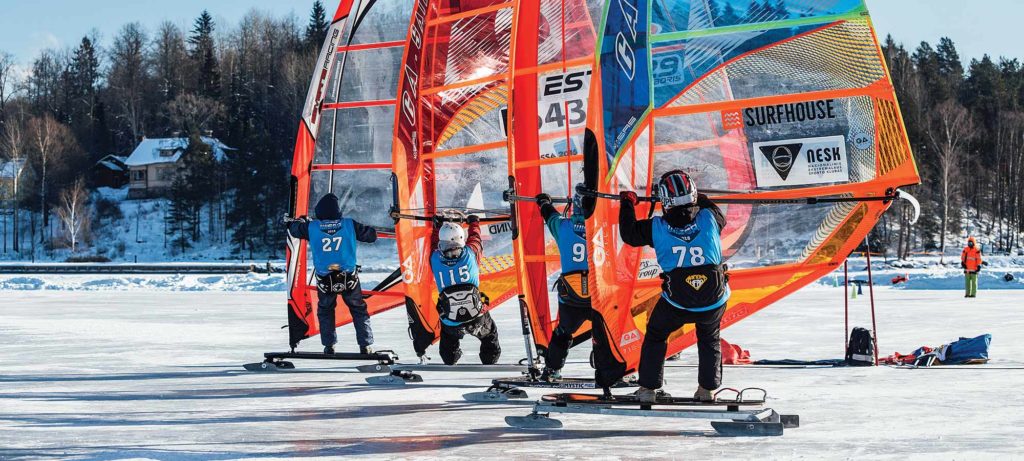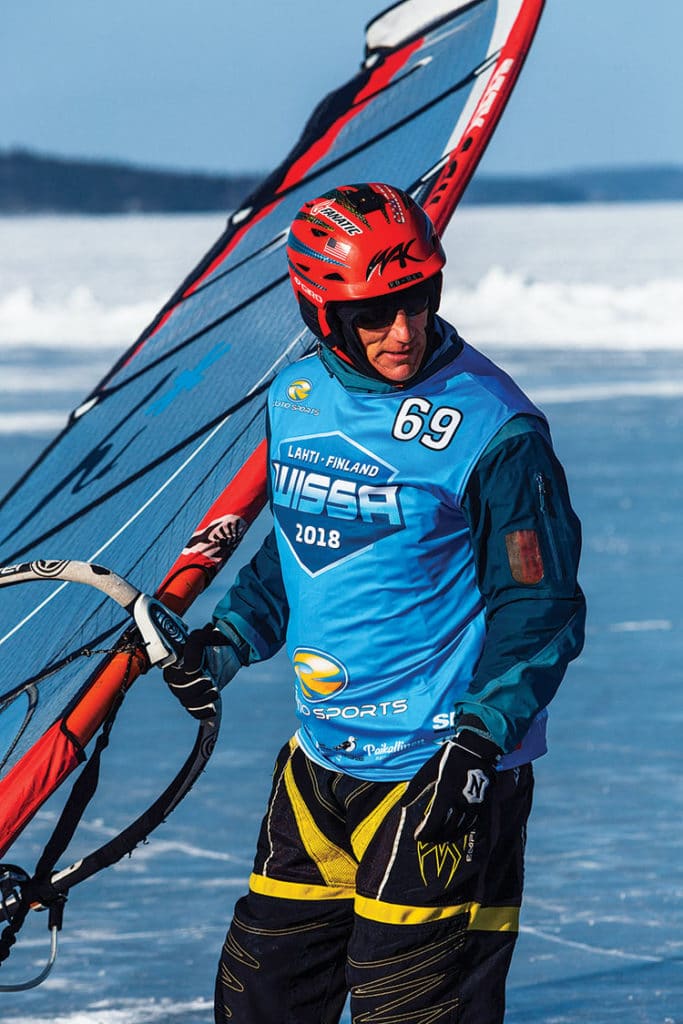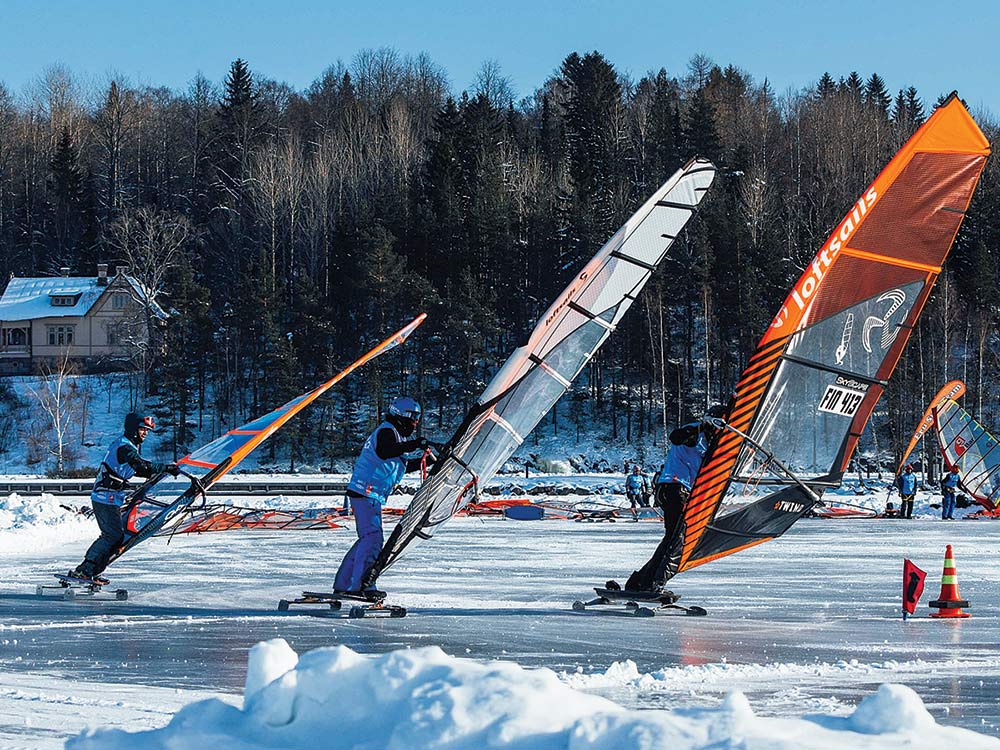
Ed Schneider is a lifer in Taycheedah, Wisconsin. His playground is Lake Winnebago, and not only during the summer when the lake is nice and soft and the wind cranks at the bottom of the lake. Today, he co-owns an amusement park and a water park, but those being seasonal, he gets his winters off. There’s no hibernating or snowbirding for this guy, though. In the heart of winter, Schneider’s happy place is on the ice, or more precisely, on a wind-powered craft, hurling himself across the ice.
We’re not talking about iceboats, either. Schneider prefers sleds pulled along by windsurfing sails, kites and handheld wings. Hours on frozen Winnebago is how he hones his skills and equipment for a little-known pastime called short-track sailing. That’s STS in the subculture of winter wind sports.
There’s nothing else like it, he says. “Jet‑fighter speed stuff, really fast. It’s about being in the zone, in 3D warp drive.”
Schneider hasn’t been short-track sailing long — 10 years or so — but its roots meander to Northern Europe long ago, where even the king of Sweden once glided across the ice with his own contraption, which is still in use today. The modern competition is contested on a rink about 120 meters in diameter, and like other forms of sailboat racing, there’s a starting line and a series of cones to round in a figure-eight reach-to-reach configuration with hairpin turns. Five racers are on the course at once, and first to finish wins the race.
A race is rarely longer than a minute.
“As soon as the start flag drops, the hair on the back of my neck is standing up,” says Schneider.
For a short-track start, racers line shoulder to shoulder, straddling handcrafted boards, or sleds, approximately 5 feet long and 20 inches wide. Beneath each sled are long stainless-steel blades mounted on custom axles or trucks with beefy rubber bushings.
At the 2018 World Ice and Snow Sailing Association Championship in Lahti, Finland, Schneider holds firm a standard-issue windsurfing boom. He’s in full battle gear: thermals, lightweight BMX body armor and a windproof layer to block the subfreezing chill, a snowboard helmet and whatever gloves will keep his hands warm between races.
“The young punks out there go with only kneepads,” he says. “But I’ve taken enough cracks to appreciate the armor.”
A cold polar wind blows perpendicular to the direction of the first leg, a 60-meter reach to the first cone. The ideal wind range for ice sailing is 15 to 20 knots. “Below 10, there’s more pumping,” says Schneider. “And when it gets to 20 or more, now we’re talking.”
Standing before him is a race official, starting flag in hand, poised high above his head. Schneider’s eyes lock on to the blue mark screwed into the ice. His legs recoil into a sprinter’s pose. His arms pull and push the boom, rocking the Mylar sail back over his shoulder. Gusts tug at the sail.

The flag drops. Schneider sprints three steps, mounts his board and violently pumps the sail. The stronger he pumps and the harder he leans into the power of the sail, the quicker he can separate from the pack. He wants to be first around that noodle, coming in high so he can arc a sharp, smooth transition onto the second leg.
Crouched in the middle of his board, his quads burning, he rakes his sail back, now careening full tilt into the turn. He gives his sail a stern pump and then gracefully lays it horizontal to the ice, pushing down against the wind with his forward arm and lifting up on the boom with his rear arm until the sail is flat to the wind.
He bends his knees and carves through the turn, pressing into the bushings, blades melting the ice into crevice wakes. Once past the noodle, he flips the sail from his left hand forward, shoves it around, shifts his feet and repositions his body for a fast exit onto the new jibe.
“The best technique is to flip the sail without ever backwinding it,” says Schneider. “You want zero speed loss. Short‑track racing is all about the turns.”
It’s also possible to take out a competitor if, and eventually, when, you wipe out and slide across the ice like a curling stone. Take someone down with you and you’re disqualified.
First to finish advances to the next top heat, last place gets bumped down and so on until the regatta’s complete. The standard STS course is the figure-eight, but there is also a format for downwind slalom: “Five marks you zig through like skiing — left, right, left, right. No matter the course, the races are intense,” says Schneider.
With the exception of sails and spars, the boards, trucks and blades are anything but standard or one-design.
When Schneider first started windsurfing on ice, the best board available was a Fiberspar Freeskate. “It was 5 feet long, the deck about a foot wide, and fiberglass. It was durable, had good flex and used the biggest skateboard trucks you could find,” he says. “The blades were 2 inches high and 12 inches long, and the thing was super fun and super fast.”

Fiberspar stopped making sleds, so Schneider and a few friends reproduced the mold and laid up about 15 of their own. Then, along came the Hiberna from Latvia. “Like a Ferrari to the Chevette,” says Schneider. “It was far better quality and a much smoother board with good-size trucks and blades. When I stepped on this machine I felt much more confident at 30 knots.”
Competitors from Northern Europe and the Baltic region have since come up with designs of equal quality and speed, and some very high-tech. A good modern sled can be laminate, wood, cored, all carbon, fiberglass or composite, and cost $800 to $1,500. For $2,000, says Schneider, you can fetch an exceptional board. The real beauty of the equipment element of the sport, he says, is that everyone claims to have the fastest board, but nobody does, so the arms race wages on.
Trucks and blades, too, are a matter of preference, experimentation and engineering gumption. There’s a whole science to the blades, says Schneider. Northern Europeans know their ice intimately and keep their blades razor sharp, obsessing over them before and between races. An on-ice pit row will have all the tools, the stones and even the belt sander required to hone the stainless-steel blades.
Schneider’s been ice sailing long enough to know when his blades are dull. “They’ll talk to you,” he says. “Especially right before they lose their bite and send you sliding on your backside through the turn.”
Sail choice is a matter of how much wind power the sailor thinks he or she can reasonably harness, and how easily they want to flip it during maneuvers. When sailing on pure ice, resistance is minimal, so a big sail is overkill, says Schneider. “To really learn how to windsurf, it’s better to start on the ice than in the water. Take out part of the equation that has the water and drifting — you’ll learn more in one hour on the ice than you would on the water. As soon as you lean into the sail, it’s pure and uninterrupted. It’s off-the-charts fun.”
Editor’s note: Schneider and his ice brethren will host and compete in the 2019 WISSA World Championships in Fond du Lac, Wisconsin, in February, an international gathering of ice sailors and ice kiters on open and short-track courses.









